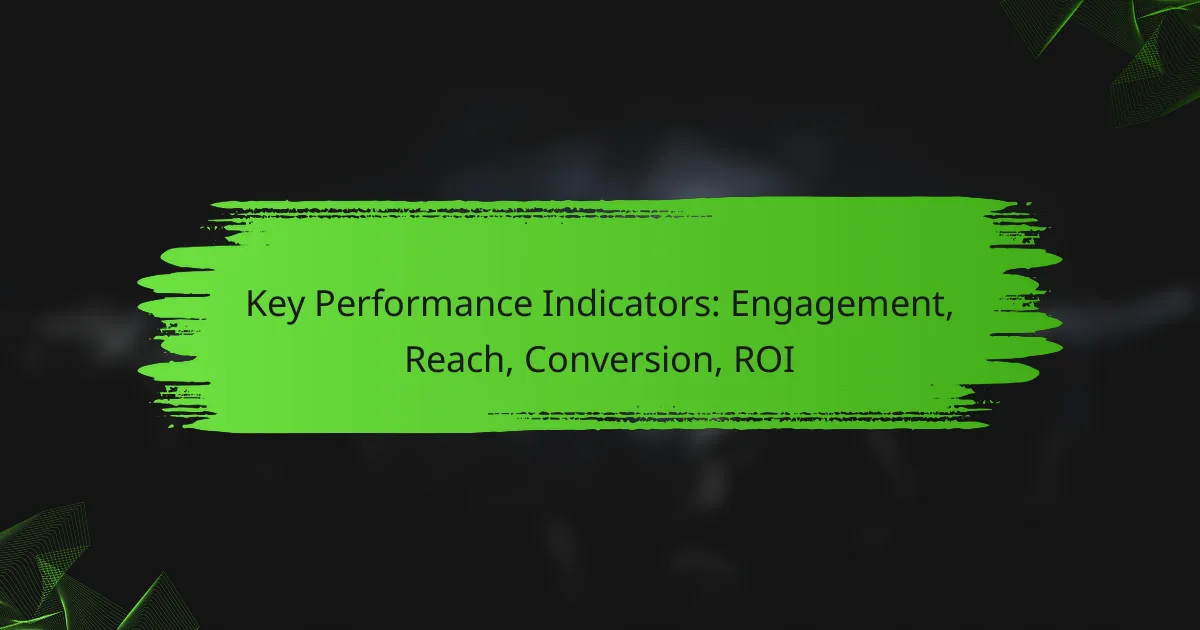Key Performance Indicators (KPIs) are essential metrics that help evaluate the success of advertising campaigns, focusing on engagement, reach, conversion, and return on investment (ROI). By analyzing user interactions, audience expansion strategies, and conversion rates, businesses can gain valuable insights into their advertising effectiveness and optimize their marketing efforts for better results.

How can engagement be measured in display advertising?
Engagement in display advertising can be measured through various metrics that indicate how users interact with ads. Key indicators include click-through rates, time spent on ads, and social media interactions, each providing insights into the effectiveness of advertising strategies.
Click-through rate (CTR)
Click-through rate (CTR) is a primary metric for measuring engagement, calculated by dividing the number of clicks an ad receives by the number of times it is shown (impressions). A higher CTR indicates that the ad is resonating with the audience, typically falling within the range of 0.5% to 5% for most industries.
To improve CTR, focus on creating compelling ad copy and eye-catching visuals. A/B testing different versions of ads can help identify what resonates best with your target audience.
Time spent on ad
Time spent on an ad measures how long users engage with the content before clicking away. This metric can provide insights into the ad’s effectiveness and relevance, with longer engagement times often indicating higher interest. Typical engagement times can range from a few seconds to several minutes, depending on the ad format.
To enhance the time spent on ads, consider using interactive elements or videos that encourage users to engage more deeply. Avoid cluttered designs that may distract from the core message.
Social media interactions
Social media interactions encompass likes, shares, comments, and overall engagement with ads on platforms like Facebook, Instagram, and Twitter. These interactions can amplify reach and visibility, as content shared by users can attract new audiences. A successful ad campaign may aim for a significant number of interactions relative to impressions.
To boost social media interactions, create shareable content that resonates with your audience’s interests. Engaging with users through comments and encouraging user-generated content can also enhance interaction rates.

What are effective strategies to improve reach?
Improving reach involves expanding your audience and ensuring your content is seen by more potential customers. Effective strategies include targeted audience segmentation, utilizing programmatic advertising, and leveraging social media platforms.
Targeted audience segmentation
Targeted audience segmentation involves dividing your audience into distinct groups based on demographics, interests, or behaviors. This allows for tailored messaging that resonates with each segment, increasing the likelihood of engagement.
To implement this, analyze your existing customer data and identify key characteristics. Use tools like surveys or analytics platforms to gather insights, and create specific campaigns for each segment. Avoid generic messaging that fails to connect with your audience.
Utilizing programmatic advertising
Programmatic advertising automates the buying and selling of online ad space, allowing for more efficient targeting and reach. This method uses algorithms and data to serve ads to the right audience at the right time, maximizing exposure.
Consider using platforms like Google Ads or Facebook Ads to set up programmatic campaigns. Monitor performance metrics closely to adjust bids and targeting strategies based on real-time data. Be cautious of overspending; set clear budgets to maintain control over costs.
Leveraging social media platforms
Social media platforms are powerful tools for expanding reach due to their vast user bases. By creating engaging content and utilizing paid promotions, brands can significantly increase visibility among potential customers.
Focus on platforms where your target audience is most active, such as Instagram for younger demographics or LinkedIn for professionals. Regularly analyze engagement metrics to refine your approach and ensure your content remains relevant. Avoid spamming; instead, prioritize quality interactions to build a loyal following.

How to calculate conversion rates in display campaigns?
To calculate conversion rates in display campaigns, divide the number of conversions by the total number of clicks, then multiply by 100 to get a percentage. This metric helps assess the effectiveness of your ads in driving desired actions, such as purchases or sign-ups.
Conversion tracking setup
Setting up conversion tracking is essential for accurately measuring conversion rates. Use tools like Google Ads or Facebook Pixel to track user actions after they click on your display ads. Ensure that the tracking code is correctly implemented on your website to capture data effectively.
Common conversion actions include form submissions, product purchases, or newsletter sign-ups. Define these actions clearly in your tracking setup to gather meaningful insights.
Attribution models
Attribution models determine how credit for conversions is assigned to various touchpoints in the customer journey. Common models include last-click, first-click, and linear attribution, each offering different perspectives on how ads contribute to conversions.
Choosing the right attribution model can significantly impact your understanding of campaign performance. For instance, last-click attribution may undervalue display ads that played a role earlier in the customer journey.
Landing page optimization
Optimizing your landing page is crucial for improving conversion rates. Ensure that the landing page aligns with the ad’s message and provides a clear call to action. A well-designed page can significantly increase the likelihood of conversions.
Consider factors such as page load speed, mobile responsiveness, and user experience. A/B testing different elements like headlines, images, and buttons can help identify what resonates best with your audience and drives conversions effectively.

What is the importance of ROI in display advertising?
ROI, or Return on Investment, is crucial in display advertising as it measures the profitability of campaigns relative to their costs. Understanding ROI helps advertisers assess the effectiveness of their strategies and make informed decisions about future investments.
Measuring campaign effectiveness
To measure campaign effectiveness, ROI provides a clear metric that indicates how much revenue is generated for every dollar spent. This can be calculated by dividing the net profit from the campaign by the total costs, then multiplying by 100 to get a percentage. A positive ROI signifies a successful campaign, while a negative ROI indicates a need for reevaluation.
For example, if a display ad campaign costs $1,000 and generates $1,500 in revenue, the ROI would be 50%. This simple calculation allows marketers to quickly gauge the success of their advertising efforts.
Budget allocation insights
ROI analysis offers valuable insights for budget allocation by highlighting which campaigns yield the best returns. By comparing the ROI of various campaigns, advertisers can identify high-performing strategies and allocate more resources to them. Conversely, campaigns with low or negative ROI may require reduced funding or complete discontinuation.
For instance, if one campaign has an ROI of 200% while another has only 50%, it makes sense to invest more in the former to maximize overall profitability.
Long-term profitability analysis
Evaluating ROI over time allows advertisers to assess long-term profitability and the sustainability of their advertising strategies. Tracking ROI trends can reveal whether certain campaigns consistently perform well or if their effectiveness diminishes over time. This information is critical for making strategic adjustments to maintain profitability.
Additionally, understanding long-term ROI can help businesses forecast future revenues and make informed decisions about scaling their advertising efforts. Regularly reviewing ROI data ensures that advertising strategies remain aligned with overall business goals and market conditions.

What frameworks can help in selecting KPIs?
Frameworks for selecting Key Performance Indicators (KPIs) provide structured approaches to identify the most relevant metrics for measuring success. These frameworks help organizations align their KPIs with strategic goals, ensuring that the chosen indicators effectively track performance and drive improvement.
SMART criteria for KPIs
The SMART criteria is a widely used framework for setting effective KPIs. Each KPI should be Specific, Measurable, Achievable, Relevant, and Time-bound. For example, instead of stating a goal to “increase sales,” a SMART KPI would specify “increase online sales by 15% within the next quarter.”
When applying the SMART criteria, ensure that your KPIs are clear and focused. Specificity helps to eliminate ambiguity, while measurability allows for tracking progress. Achievability ensures that the goals are realistic, and relevance aligns the KPIs with broader business objectives. Finally, setting a time frame creates urgency and accountability.
Industry benchmarks
Industry benchmarks provide a reference point for evaluating your KPIs against competitors or market standards. These benchmarks can help you understand what constitutes good performance within your sector. For instance, a digital marketing campaign might aim for a conversion rate of 2-5%, depending on the industry.
To effectively use industry benchmarks, research reliable sources such as industry reports, trade associations, or analytics platforms. Compare your KPIs to these benchmarks to identify areas for improvement. However, be cautious of relying solely on benchmarks; they should complement your unique business context and goals.

How do engagement and reach impact conversions?
Engagement and reach are critical factors that significantly influence conversions. High engagement indicates that users are interacting with your content, while a broad reach ensures that more potential customers are exposed to your offerings, ultimately driving conversion rates higher.
Understanding Engagement
Engagement refers to how actively users interact with your content, such as liking, sharing, or commenting on posts. It is a key indicator of how well your message resonates with your audience. Higher engagement levels often lead to increased brand loyalty and a greater likelihood of conversion.
To enhance engagement, consider using interactive content like polls, quizzes, or live Q&A sessions. These formats encourage participation and can significantly improve user interaction. Aim for engagement rates that are above industry averages, typically ranging from 1% to 5% depending on your sector.
Understanding Reach
Reach measures the total number of unique users who see your content. A wider reach increases the chances of attracting potential customers, which is essential for driving conversions. It’s important to balance reach with engagement; simply reaching a large audience without engagement may not lead to meaningful conversions.
To expand your reach, utilize social media platforms, SEO strategies, and paid advertising. Consider targeting specific demographics to ensure that your content reaches the right audience. A good goal is to achieve a reach that is at least three times your engagement to maximize conversion potential.
Linking Engagement and Reach to Conversions
The connection between engagement, reach, and conversions is direct. Increased engagement often leads to higher conversion rates as users who interact with your content are more likely to make a purchase. Conversely, a broad reach can introduce your brand to new audiences, increasing the pool of potential converters.
To effectively link these metrics, track your analytics regularly. Use tools like Google Analytics or social media insights to monitor how engagement and reach correlate with conversion rates. Adjust your strategies based on this data to optimize performance and drive better results.


